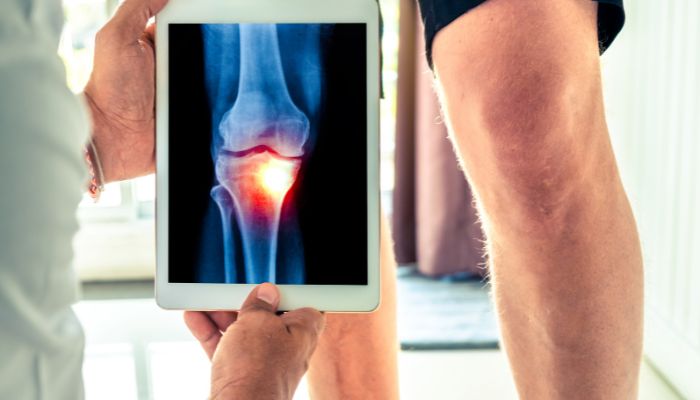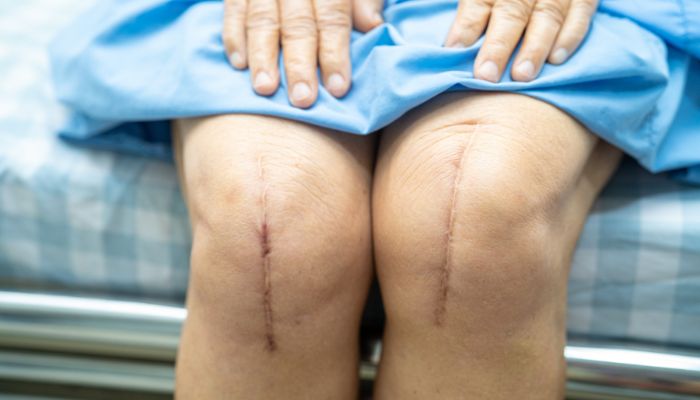
If your knee is acutely damaged as a result of arthritis or injury, you may find it difficult to carry out simple activities like walking or climbing stairs. You may even experience pain while sitting or lying down.
If non-surgical treatments, such as medications and walking aids, are no longer effective, you may want to consider total knee replacement surgery. Knee replacement surgery is an effective solution and effective for relieving pain, correcting leg deformity, and allowing you to return to normal activities.
Our orthopaedic surgeon Dr Omar Sabri offers the best knee replacement surgery in Dubai with utmost precision and well-guided aftercare.
If you wish to know about knee replacement surgery, then first, you need to understand the knee anatomy.
The knee is an intricate joint in the body that is made up of three bones:
To control knee motion and function, strong ligaments connect the powerful thigh and calf muscles to the bones around the knee. Cartilage and other soft tissues cover and cushion the bones, allowing them to move smoothly together. The femur, femoral condyle, medial collateral ligament (MCL), medial meniscus, tibia, anterior cruciate ligament (ACL), and patella (kneecap) are labeled on this knee joint diagram.
When you bend or straighten your knee, the femur’s end rolls against the tibia’s end, and the patella glides in front of the femur.
Dr Omar Sabri, our best knee replacement burgeon in Dubai, may recommend surgery when the cartilage that cushions the joint mortifies or wears away.
Knee replacement involves the removal of portions of the bones that make up the knee joint and their replacement with artificial implants. It is primarily used to treat knee pain and stiffness caused by osteoarthritis.
The majority of people who have this surgery have advanced knee arthritis, in which the cartilage in the knee has worn away and the surface of the knee has become pitted, eroded, and uneven. Some people may benefit from this surgery if they have a weakened knee joint as a result of an injury or another condition.

Arthritis is the primary cause of knee replacement surgery. There are majorly three major types of arthritis:
A knee replacement surgery can treat the following symptoms that bother your knee:
Our orthopedic surgeon begins by making an incision (cut) in the knee and repositioning the patella (kneecap) to the side. If there are any bone spurs (small bony growths) present, which is common in osteoarthritis, they will be removed.
Following that, the two menisci between the femur and tibia, as well as the anterior cruciate ligament (ACL) and, in some cases, the posterior cruciate ligament (PCL), are removed. The PCL is retained in some types of knee replacement.
The surgeon cuts and removes cartilage and some bone from the upper part of the tibia and lower sections of the femur during the main phase of the operation. The femoral sections that have been removed are two knobby protuberances known as the femoral condyles. The tibia and femur are then capped with metal implants to create new joint surfaces. The femoral component’s surface mimics the shape of the original femoral condyles. If the kneecap has also degraded, the underside surface may be removed and replaced with a polyethylene implant.
Lastly, dissolvable sutures are used to repair the various layers of tissue, and the skin incision is closed with sutures or surgical staples. A bandage will be wrapped around the patient’s knee, and he or she will be taken to recovery.
Partial knee replacement, also known as unicompartmental knee replacement, is a surgical procedure that addresses knee pain and limited mobility by replacing only the damaged or arthritic part of the knee joint. Unlike total knee replacement, this option preserves healthy knee tissue, potentially leading to a quicker recovery and improved joint function. If you’re experiencing knee pain localized to a specific area of your knee, partial knee replacement may be a suitable, less invasive option to consider, offering targeted relief and enhanced mobility.
Consulting our best knee replacement surgeon in Dubai can help determine if this procedure aligns with your specific needs and circumstances.
Each patient’s choice of knee replacement prosthesis design and materials is unique. The primary implant components are metal, typically titanium or chrome-cobalt alloys. The implants are either cemented in place or osseointegrated. These implants have porous metal stems that extend into the tibia and the patient’s natural bone grows into it. Following this, a plastic platform is inserted between the tibial and femoral implant surfaces. Polyethylene is used to make the spacer.
Metal alloys or metal-ceramic alloys (oxidized zirconium) are used to make the majority of femoral components. The patellar component is made of polyethylene (plastic). The tibial insert is also made of plastic (polyethylene).
The following materials can also be used to make the tibial tray component:
In 85% to 90% of patients, knee replacement implants are expected to last at least 15 to 20 years. However, the implants do not last indefinitely.
General wear and tear may loosen or damage the implant after 15 to 20 years. Depending on the patient, this could result in none of the following symptoms:
Our surgeon may suggest knee revision surgery to replace the original implant when these symptoms appear. Infection, in particular, necessitates an immediate revision surgery. Infection after knee replacement surgery is uncommon, but if bacteria enter the body, the knee replacement implant cannot defend itself.
Within 24 hours of surgery, rehabilitation (physical therapy) will begin. Following your surgery, the nursing staff will place you in bed and assist you in turning until you are able to move on your own. If your surgeon orders it, you may have a pillow between your legs.
A physical therapist will teach you appropriate exercises and review your progress after your surgery. Gentle range-of-motion exercises can help prevent circulation problems while also strengthening your muscles.
A physical therapist will teach you suitable exercises and review your progress after your surgery. Gentle range-of-motion exercises can help prevent circulation problems while also strengthening your muscles.
Your rehabilitation program will begin immediately after you are medically stable and your doctor gives you the green light to begin postoperative mobility. Within 24 hours of their surgery, all patients begin their rehabilitation. The success of your surgery and recovery is dependent on your motivation and participation in your physical therapy program. The physical therapist will help you with the following tasks:
Yes, healthy patients below the age of 75 who have no cardiopulmonary disease may be candidates for this surgery. Our orthopedist can tell you more about the procedure.
Most patients can begin walking with the assistance of a straight cane, walker, or crutches within two or three days of surgery. As the days progress, the distance and frequency of walking will increase.
Patients can usually drive a car 3 to 6 weeks post-surgery and resume most other normal activities by six weeks. It may take four months or more to recover completely and gain full strength and mobility. However, in many cases, one month after surgery, patients are significantly more mobile than they were before their knee replacement.
When it comes to dealing with orthopaedic issues, it’s important to seek out the best possible care. That’s why choosing Dr Omar Sabri for your knee replacement surgery in Dubai is a wise decision. With his expertise and advanced techniques, you can be rest assured that you will experience top-notch treatment and achieve optimal results.
Don’t let knee pain hold you back any longer – contact Dr Omar Sabri today and take the first step towards a healthier and more active life!
There is no exact formula for determining when a knee replacement is necessary. The main reason for having it done is pain, but if you have exhausted all non-surgical options, such as lifestyle changes, anti-inflammatory medication, physical therapy, and injections, it may be time to consider surgery.
Metal and medical-grade plastic, known as polyethylene, are used to make artificial knee implants.
The components can be attached to the bone in two ways. One option is to use bone cement, which takes about 10 minutes to set. The other method is a cement-free approach in which the components are coated with a porous coating that allows bone to grow onto them.
Our orthopaedic surgeon may use both techniques during the same operation in some cases.
Any operation requiring anaesthesia carries risks, though severe complications from any type of anaesthesia are uncommon.
Dr Omar, our best knee replacement surgeon in Dubai, will examine you thoroughly and make a recommendation.
Many patients who do activities such as home finishing, renovations, or even gardening find that sensitivity while kneeling takes a year or longer to go away. If this type of work is required, heavy-duty knee pads may provide relief, or you can try a thick pad on the ground beneath you. Knee replacement patients are not prohibited from kneeling, but most experience discomfort when attempting to kneel.
Knee replacement recovery is highly variable and is heavily influenced by your level of activity and conditioning prior to surgery. Maintaining muscle strength and mass is critical, and patients who are more active before surgery are typically more active after surgery. In general, a knee replacement should restore full motion in six to eight weeks, with increased mobility in the months that follow.
If you are looking for the best knee replacement surgery in Dubai, get in touch with our knee specialist and highly experienced surgeon, Dr Omar Sabri.